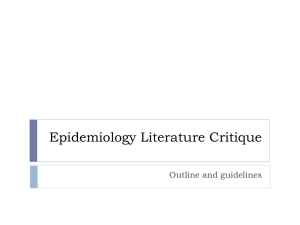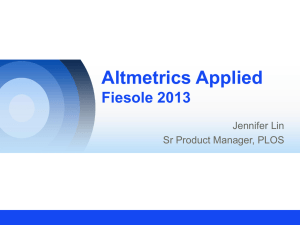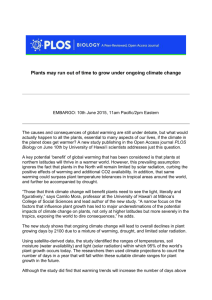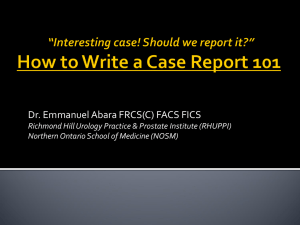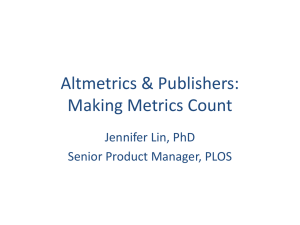PPT 2.4MB
advertisement
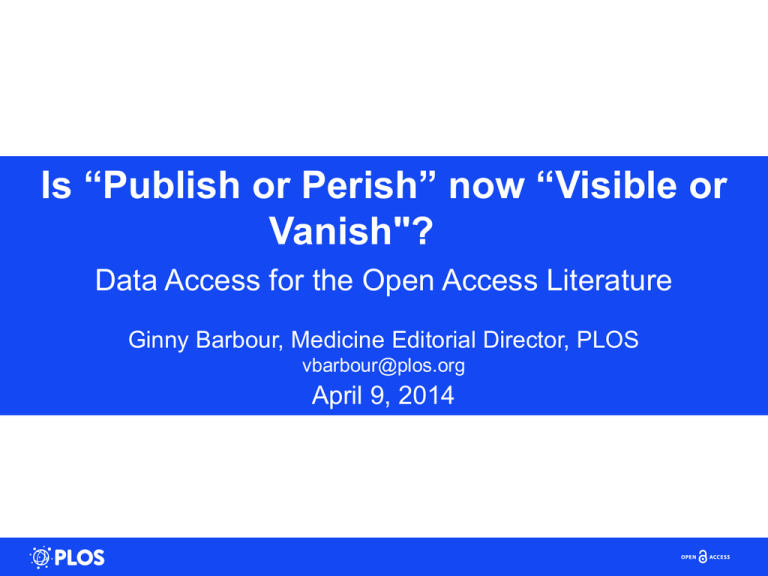
Is “Publish or Perish” now “Visible or Vanish"? Data Access for the Open Access Literature Ginny Barbour, Medicine Editorial Director, PLOS vbarbour@plos.org April 9, 2014 PLOS Biology Founded in October, 2000 October 2003, 1st journal, launched October, 2003 Now seven journals Diverse sources of revenue PLOS Medicine Publication Fees October, 2004 NB assistance programme Institutional and individual memberships PLOS Community Journals Advertising June-September, 2005 October, 2007 PLOS ONE 2 December, 2006 2 Previous PLOS Data Access Policy • PLOS is committed to ensuring the availability of data and materials that underpin any published articles • Authors should make all relevant data immediately available without restrictions (exc patient confidentiality) • Authors must comply with current best practices in their discipline Failure to comply • May affect decision to publish • If after publication researchers cannot obtain data, PLOS may publish a correction, contact authors' institutions and funders, or in extreme cases withdraw publication 3 Data availability in research papers allows Replication Validation New analysis Better interpretation Inclusion in meta-analyses Facilitation of reproducibility of research Closer scrutiny of published work Better ‘bang for the buck’ out of research investment From: How Does the Availability of Research Data Change With Time Since Publication? Timothy H. Vines and colleagues, Abstract (podium), Peer Review Congress, 2013 5 6 7 Committee on Publication Ethics Cases, Classifications & Keywords, 1997-2012 Number Mean COPE Slides from Irene Hames Classification of COPE cases, 1997-2012, categories with >7 instances in a 4-year period Group 3: increasing cases relevant to data Data • top over 16yr - fabrication 17%, selective/misleading reporting/interpretation 13%; • 2009-12 – unauthorized use & image manipulation Correction of the literature • retractions 47%, corrections 27%, expressions of concern 11%, disputes 9%, corrigenda & errata 6% Misconduct/questionable behaviour • author 60%, reviewer 27%, editor 11%, instit 1%, soc/jrnl owner 1% Do some research Integrated collection of methods, results, data, metadata Write a narrative description that is inextricably linked to the data and methods Store all data in accessible, usable format, link to publication Facilitate re-use & replication – by people or machines Reality • • • • • • Patient privacy concerns Unextractable data Everything “extra” in one file Third party licenses Proprietary data No metadata 12 Previous PLOS Data Access Policy • PLOS is committed to ensuring the availability of data and materials that underpin any published articles • Authors should make all relevant data immediately available without restrictions (exc patient confidentiality) • Authors must comply with current best practices in their discipline Failure to comply • May affect decision to publish • If after publication researchers cannot obtain data, PLOS may publish a correction, contact authors' institutions and funders, or in extreme cases withdraw publication 13 Aims of New PLOS Data Policy • Ensuring access to the underlying data should be an intrinsic part of the scientific publishing process • To ensure that all steps, from authoring to publication, capture data and its associated metadata well and then present them in optimal human and machine-readable formats to all readers and users of PLOS-published research 14 Background and rationale • Update PLOS-wide data sharing policy (at http://www.plosone.org/static/policies#sharing) • Establish clarity with respect to authors’ obligations • New policy highlights author’s responsibility to determine and describe a data sharing plan • New policy contains enhanced enforcement mechanism • Therefore ensures transparency, i.e. compliance with policy is externally visible to readers (and to Academic Editors/referees in peer review) • Aim to ensure policy is workable across scientific fields, and takes account of special considerations for privacy (in relation to human-subject research, and other issues) 15 Key features of the new policy (1) • “PLOS journals require authors to make all data underlying the findings described in their manuscript fully available without restriction, with rare exception.” • “When submitting a manuscript online, authors must provide a Data Availability Statement describing compliance with PLOS’s policy. The data availability statement will be published with the article if accepted.” 16 Definition of “All Data” • The dataset used to reach the conclusions drawn in the manuscript with related metadata and methods AND • Any additional data required to replicate the reported study findings in their entirety – Core descriptive data, methods, and study results should be included within the main paper, regardless of data deposition (PMC issue) – No “data not shown” – Authors who have datasets too large for sharing via repositories or uploaded files should contact the relevant journal for advice 17 Key features of the new policy (1) • “PLOS journals require authors to make all data underlying the findings described in their manuscript fully available without restriction, with rare exception.” • “When submitting a manuscript online, authors must provide a Data Availability Statement describing compliance with PLOS’s policy. The data availability statement will be published with the article if accepted.” 18 Key features of the new policy (2) Acceptable data-sharing methods: • Data deposition (strongly recommended; must include DOIs or accession numbers ) • Data in supporting information files (in file format from which data can be efficiently extracted) 19 Choosing a data repository • Authors must comply with field-specific standards for preparation and recording of data and to select repositories appropriate to their field, eg – microarray data in ArrayExpress or GEO – gene sequences in GenBank, EMBL or DDBJ – deposition of ecological data in Dryad • Should meet accepted criteria as trustworthy, eg, Centre for Research Libraries or Data Seal of Approval • If licensing policy is stated, at least CC-BY 20 Key features of the new policy (2) Acceptable data-sharing methods: • Data deposition (strongly recommended; must include DOIs or accession numbers ) • Data in supporting information files (in file format from which data can be efficiently extracted) 21 Key features of the new policy (3) The following two methods may be acceptable alternatives, subject to case-by-case evaluation: • Data made available to all interested researchers upon request (only where deposition is not ethical or legal, eg, studies involving human participants; NOT from the authors themselves but from an ethics or oversight committee) • Data available from third party (only where authors did not generate the primary dataset themselves but it is available) 22 Data available on request • Identify the group to which requests should be submitted (eg, a named data access committee or named ethics committee). – Note that it is not acceptable for the authors to be the sole named individuals responsible for ensuring data access • The reasons for restrictions on public data deposition must also be specified. 23 Data with privacy concerns Guidance on sharing data with privacy issues for human participants: • Data handled so as to not compromise participants’ privacy • Follow established guidance and applicable local laws; national resources such as NIH • Authors should indicate, as part of the ethics statement, the ways in which the study participants’ privacy was preserved. If license agreements apply, note the process necessary for other researchers to obtain a license. 24 Key features of the new policy (3) The following two methods may be acceptable alternatives, subject to case-by-case evaluation: • Data made available to all interested researchers upon request (only where deposition is not ethical or legal, e.g. studies involving human participants; NOT from the authors themselves but from an ethics or oversight committee) • Data available from third party (only where authors did not generate the primary dataset themselves but it is available) 25 Key features of the new policy (4) Specification of restrictions unacceptable to PLOS • Author refusal to share because of personal reasons such as patents or future publications • Analysis rests solely on proprietary data: If proprietary data are used, the manuscript must include an analysis of public data that validates the conclusions so others can reproduce the analysis and build on the findings 26 Key features of the new policy (5) Failure to comply • May affect decision to consider or to publish the manuscript • If after publication researchers cannot obtain data, PLOS may publish a correction, contact authors' institutions and funders, or in extreme cases withdraw publication 27 Development of new policy • Steering committee included journal editors who are also active researchers • Data policy committee involving individuals from and communicating with all levels of journal review and production • Presentations at conferences • Review of policy iterations and communications before public release • Two blogs on the PLOS blog 3 and 1 months before launch asking for feedback 28 Pre-implementation questions from researchers • What to do with massive datasets? • What if the researcher plans to publish additional studies using the data? • What if competitors take advantage? • In cases of “data available on request,” what if no data access committee exists and the IRB is not willing to take on the responsibility? • Concerns over privacy for human data 29 Implementation: submission 30 Implementation: article 31 Open Issues • How much data, metadata, and explanation are necessary for replication? • How to cite data • How to give academic credit for data reuse • Funding for costs of data sharing • Who determines who can access private data? • What are best practices for data access committees? Who will fund them? • What file formats should be acceptable? • Future preservation of data in obsolete file formats • How much peer review of data is sufficient? 32 Questions and comments • FAQ is available – http://www.plosone.org/static/policies#faqs • Authors who have questions or difficulties with the policy, or readers who have difficulty accessing data, are encouraged to contact the relevant journal office or data@plos.org 33


